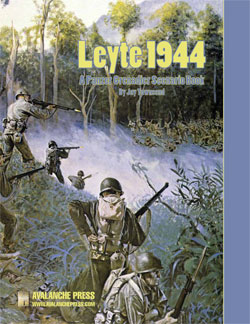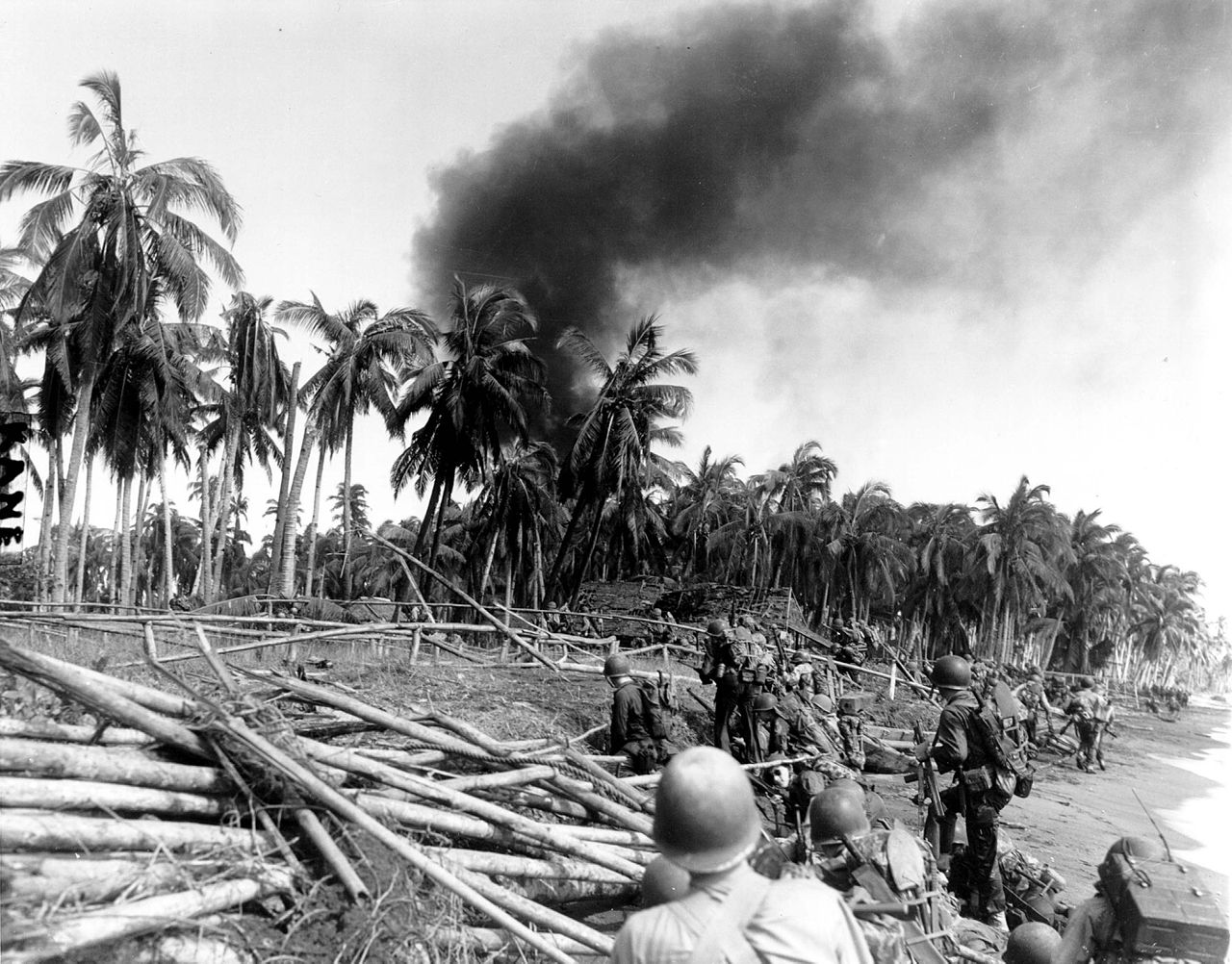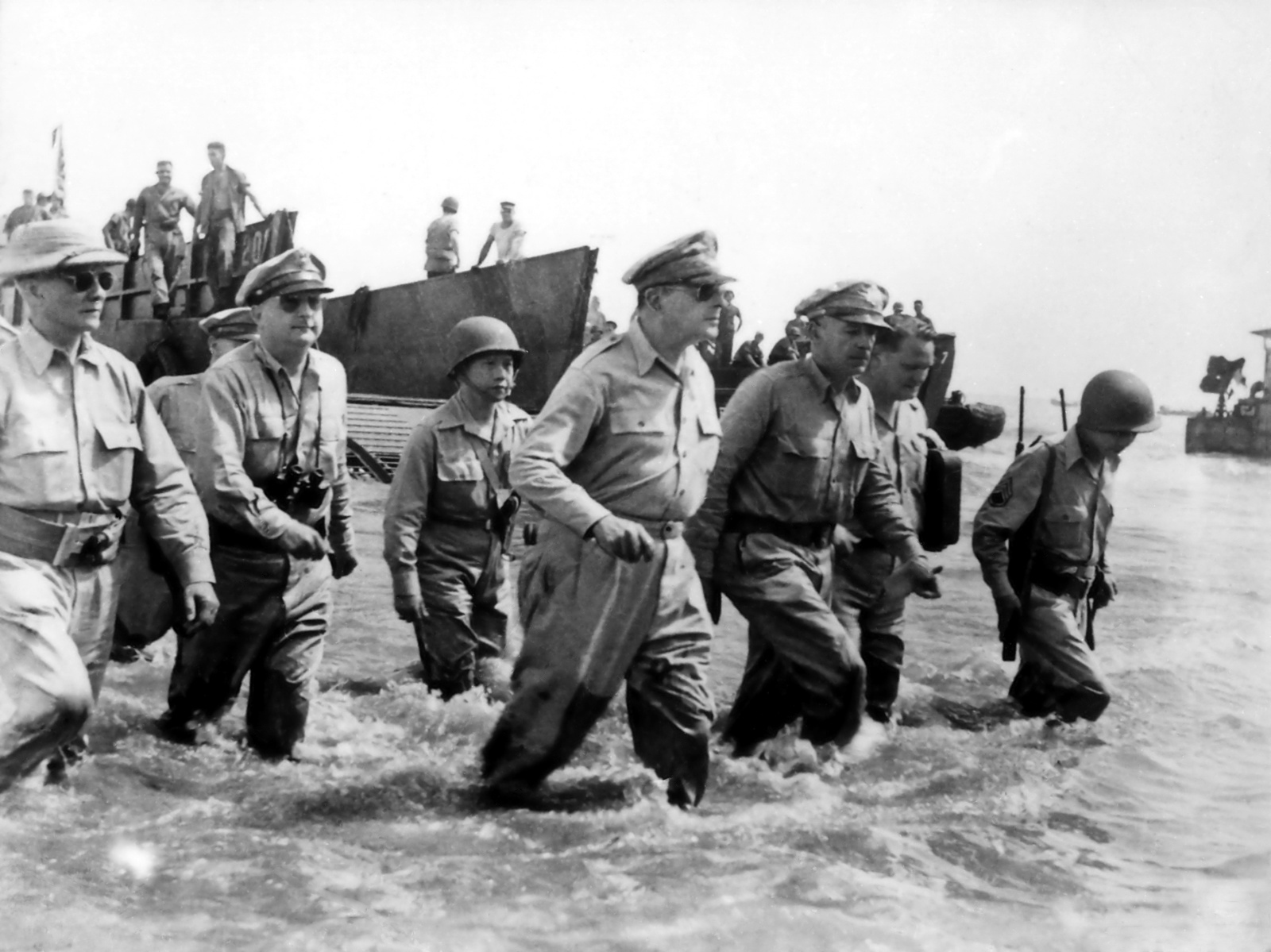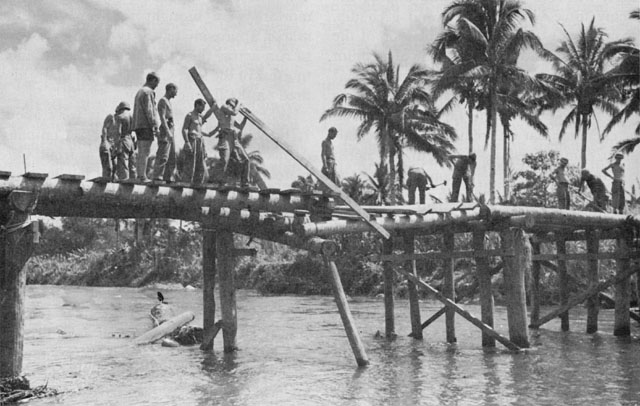| Leyte 1944:
The Battle, Part Two
by Mike Bennighof, Ph.D.
July 2020
 The first Americans to return to the Philippines were Rangers of the newly-established 6th Battalion, who secured the small islands in the mouth of Leyte Gulf on the morning of 18 October. They met some resistance, but soon overcame it and set up navigation lights to help the approaching invasion fleet enter the gulf. The first Americans to return to the Philippines were Rangers of the newly-established 6th Battalion, who secured the small islands in the mouth of Leyte Gulf on the morning of 18 October. They met some resistance, but soon overcame it and set up navigation lights to help the approaching invasion fleet enter the gulf.
The Americans had hoped to take the Japanese by surprise, and the approaching storm had helped cover the fleet’s advance. By the 17th the Japanese realized that the Americans intended to land in the central Philippines and moved their air units to counter-attack. On the afternoon of the 18th American Underwater Demolition Teams began working to removed obstacles in front of the landing beaches on Leyte, under cover of American warships, and drew heavy fire from the defenders. Meanwhile battleships and cruisers began to work over first the southern landing beaches, and then the northern ones as well.
The troops came ashore at 0600 on 20 October, designated as A Day, under perfect weather with very light surf. The massive bombardment had crushed many of the Japanese front-line positions and artillery batteries, but in some places the defenders managed to meet the invaders with strong machine-gun and artillery fire. By 1430 the X Corps (northern) beachhead was secure enough to allow Gen. Douglas MacArthur to wade ashore for a photo opportunity before returning to the cruiser Nashville. More importantly, 1st Cavalry Division captured Tacloban Airfield though it took two more days to take the city of Tacloban itself.

Sound Garryowen. The 7th Cavalry Regiment moves off the beaches.
The XXIV Corps (southern) landings faced slightly greater difficulties, as the Japanese had expected landings in this sector, and the assault included the green 96th Infantry Division. The U.S. official history would make excuses about the terrain and the recent rainy weather for 96th Infantry Division. The neighboring 7th Infantry Division did somewhat better, but failed to secure the crucial Dulag Airfield by the end of the day. The Japanese withdrew from the airfield during the night and the Americans took it during the early morning hours of the 21st.
All told the Americans suffered fewer than 50 killed in action on the first day, including heroic Medal of Honor winner Francis Wai. Sixth Army’s staff apparently did a poor job combat-loading the invasion transports (so that the most-needed items were off-loaded first) and the invasion beaches quickly became a jumble of crates, boxes and barrels as badly-needed supplies could not be found.
Over the next several days, X Corps captured Tacloban and moved on toward Carigara, a small port on Leyte’s north coast. Meanwhile XXIV Corps marched on Burauen, a crossroads town that dominated one of the few passes through the mountain range that formed the island’s spine.

A lot of effort for a photo op: Douglas MacArthur comes ashore on Leyte.
With only one division on the island, the Japanese offered resistance but could not stem the American advance. Japanese commanders argued over their response, with some wishing to conserve their forces to defend Luzon, the main island of the Philippines and its economic, transportation and political center; others argued that Luzon could not be defended if the Americans secured a foothold elsewhere in the archipelago. The latter view prevailed, and a day after the Americans landed Yamashita ordered reinforcements to proceed to Leyte and conduct a counter-attack to throw the Americans off the island. His subordinate 35th Army directed still more troops to Leyte.
Elements of four divisions and three independent brigades soon began to move to Leyte; most of them left a few battalions behind to garrison their former locations. Additional artillery units set out as well. Japanese intelligence believed that the Americans had landed with just two divisions; five Japanese divisions should be able to crush them. Since the American fleet had been devastated off Formosa, it would be unable to reinforce them once the Imperial Navy had finished its own counter-attack, slated for the 25th.
Once again, Japanese strategic and operational thinking was dominated by a fatal combination of magical thinking and contempt for the enemy.
The Japanese 102nd Infantry Division began to arrive at Ormoc on the west coast of Leyte on the 23rd, with five battalions of three different formations unloading there two days later. The new division moved to the Japanese northern flank to face X Corps, while 16th Infantry Division shifted southward to concentrate against XXIV Corps. With each Japanese division facing two larger and far more powerful American ones, the division commanders cancelled planned counter-attacks while their bosses continued to plan the moves that would throw the Americans into the sea. On the American side, Filipino guerillas accurately identified the newly-arrived Japanese units and quickly passed this information to Sixth Army intelligence.
With 16th Infantry Division able to put more troops into its front line, the American advance on Burauen moved forward slowly. Seventh Infantry Division troops entered the town on the 23rd, and finally secured the nearby airfields four days later. The Japanese had prepared positions all along the route, which the Americans countered with massive doses of artillery, naval gunfire and air support. A series of three successive typhoons scrambled the American landing beaches and grounded their air support for several days, and allowed the Japanese reinforcement convoys crossing the sheltered internal waters west of Leyte to arrive without facing American air attacks.
On the northern flank, the Japanese feared that the Americans would use their control of the strait north of Leyte to land behind them. The 102nd Infantry Division pulled out of Carigara on 1 November, with the Americans moving in a day later. With both the northern and southern ends of the Leyte Valley in American hands, they now could move to secure all of the island east of the mountains, but the ridge line remained in Japanese hands.

Philippine infrastructure often proved inadequate to American needs.
The jungle-covered mountains gave the Japanese a formidable natural fortress, but already the Americans had outflanked them. A battalion from 7th Infantry Division marched southward along the coastal road against no meaningful opposition, then turned west along the roads skirting the southern edge of the mountain range. The Japanese did little to stop them, and by 2 November the Americans had reached the island’s west coast at Baybay.
Meanwhile the Japanese naval and air counter-attack, the Sho-Go Operation which resulted in the Battle of Leyte Gulf, ended in unmitigated disaster. The American fleet had not been crippled off Formosa, and it proceeded to devastate the Japanese. The Imperial Navy had been eliminated as a significant factor; the Imperial Army was on its own.
Click here to order Leyte 1944.
Please allow an additional four weeks for delivery.
Sign up for our newsletter right here. Your info will never be sold or transferred; we'll just use it to update you on new games and new offers.
Mike Bennighof is president of Avalanche Press and holds a doctorate in history from Emory University. A Fulbright Scholar and NASA Journalist in Space finalist, he has published eleventy-million books, games and articles on historical subjects.
He lives in Birmingham, Alabama with his wife, three children, his dog Leopold and Egbert the pet turkey.
|
